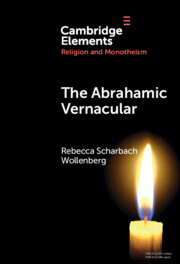Refine search
Actions for selected content:
44 results
Asserting Protestant Legitimacy in a Catholic Context: Rhetorical Strategies of the Confederação Evangélica do Brasil, 1930s–1950s
-
- Journal:
- Church History , First View
- Published online by Cambridge University Press:
- 21 October 2025, pp. 1-17
-
- Article
-
- You have access
- Open access
- HTML
- Export citation
18 - Liturgy and Ecumenism
- from Part IV - Liturgy and the Life of the Churches
-
-
- Book:
- The Cambridge Companion to Christian Liturgy
- Published online:
- 19 September 2025
- Print publication:
- 09 October 2025, pp 317-334
-
- Chapter
- Export citation
8 - “It Was Not That Kind of War”: January 1972–February 1973
-
- Book:
- Less Than Victory
- Published online:
- 16 October 2025
- Print publication:
- 11 September 2025, pp 251-283
-
- Chapter
- Export citation
Breathing with two lungs – the metaphor revisited, refreshed, renewed
-
- Journal:
- Ecclesiastical Law Journal / Volume 27 / Issue 3 / September 2025
- Published online by Cambridge University Press:
- 04 October 2025, pp. 389-397
- Print publication:
- September 2025
-
- Article
-
- You have access
- Open access
- HTML
- Export citation
26 - The Popes and the Protestant Churches
- from Part V - Inter-Faith Relations: Confrontation and Dialogue
-
-
- Book:
- The Cambridge History of the Papacy
- Published online:
- 28 February 2025
- Print publication:
- 20 March 2025, pp 674-696
-
- Chapter
- Export citation
Chapter 13 - Victorian Roman Catholicism
- from Part III - Religious, Theological, and Philosophical Contexts
-
-
- Book:
- Gerard Manley Hopkins in Context
- Published online:
- 16 January 2025
- Print publication:
- 16 January 2025, pp 110-117
-
- Chapter
- Export citation

The Abrahamic Vernacular
-
- Published online:
- 10 April 2024
- Print publication:
- 25 April 2024
-
- Element
- Export citation
Dialogue or Confession? Ecumenical Responsibility and the War in Ukraine
-
- Journal:
- Journal of Anglican Studies / Volume 21 / Issue 2 / November 2023
- Published online by Cambridge University Press:
- 26 July 2023, pp. 246-259
-
- Article
- Export citation
Chapter Five - Constituting Rights
- from Part II - Constituting Difference
-
- Book:
- Entangled Domains
- Published online:
- 18 May 2023
- Print publication:
- 01 June 2023, pp 189-226
-
- Chapter
- Export citation
Chapter 7 - ‘Jarrett’s Jam’
-
- Book:
- The Dominicans in the British Isles and Beyond
- Published online:
- 02 March 2023
- Print publication:
- 09 March 2023, pp 273-330
-
- Chapter
- Export citation
The 2022 Revision of The Principles of Canon Law Common to the Churches of the Anglican Communion
-
- Journal:
- Ecclesiastical Law Journal / Volume 25 / Issue 1 / January 2023
- Published online by Cambridge University Press:
- 05 January 2023, pp. 60-65
- Print publication:
- January 2023
-
- Article
-
- You have access
- Open access
- HTML
- Export citation
22 - The Stone-Campbell Movement
- from Part III - Theological Traditions
-
-
- Book:
- The Cambridge Companion to American Protestantism
- Published online:
- 11 May 2022
- Print publication:
- 26 May 2022, pp 419-434
-
- Chapter
- Export citation
11 - Standards for a Righteous and Civilized World: Religion and America’s Emergence as a Global Power
-
-
- Book:
- Christianity and International Law
- Published online:
- 17 May 2021
- Print publication:
- 20 May 2021, pp 223-245
-
- Chapter
- Export citation
Communion and Jurisdiction
-
- Journal:
- Ecclesiastical Law Journal / Volume 23 / Issue 2 / May 2021
- Published online by Cambridge University Press:
- 27 April 2021, pp. 200-208
- Print publication:
- May 2021
-
- Article
- Export citation
6 - Faith
- from Part II - From the First Intifada to the Oslo Agreement (1988–2000)
-
- Book:
- A History of Palestinian Islamic Jihad
- Published online:
- 22 January 2021
- Print publication:
- 28 January 2021, pp 129-143
-
- Chapter
- Export citation
I. Introduction
-
- Article
- Export citation
Richard Hooker and Mission and Ministry in Covenant
-
- Journal:
- Journal of Anglican Studies / Volume 18 / Issue 2 / November 2020
- Published online by Cambridge University Press:
- 05 June 2020, pp. 215-234
-
- Article
- Export citation
16 - Ecumenism
- from Part II - Conciliar Themes and Reception
-
-
- Book:
- The Cambridge Companion to Vatican II
- Published online:
- 14 May 2020
- Print publication:
- 28 May 2020, pp 282-302
-
- Chapter
- Export citation
12 - The Church and Other Communities of Faith
- from Part III - Doctrine, Liturgy, Rites and Other Faith Communities
-
-
- Book:
- A New History of the Church in Wales
- Published online:
- 22 February 2020
- Print publication:
- 05 March 2020, pp 215-236
-
- Chapter
- Export citation
Trapped in the imperial narrative? Some reflections on warfare and the provincial masses in Byzantium (600-1204)
-
- Journal:
- Byzantine and Modern Greek Studies / Volume 44 / Issue 1 / April 2020
- Published online by Cambridge University Press:
- 19 February 2020, pp. 1-20
- Print publication:
- April 2020
-
- Article
- Export citation
